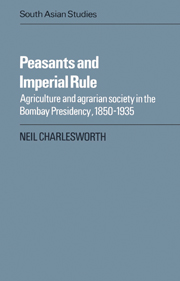Book contents
- Frontmatter
- Contents
- List of maps and tables
- Preface
- Note on technical terms and references
- Maps
- 1 Introduction: the peasant in India and Bombay Presidency
- 2 The village in 1850: land tenure, social structure and revenue policy
- 3 The village in 1850: land and agriculture
- 4 Indebtedness and the Deccan Riots of 1875
- 5 Continuity and change in the rural economy, 1850–1900
- 6 The Bombay peasantry, 1850–1900: social stability or social stratification?
- 7 The agricultural economy, 1900–1935: the critical watershed?
- 8 The impact of government policy, 1880–1935
- 9 The peasant and politics in the early twentieth century
- 10 Conclusions: the problem of differential commercialisation
- Glossary
- Bibliography
- Index
2 - The village in 1850: land tenure, social structure and revenue policy
Published online by Cambridge University Press: 10 December 2009
- Frontmatter
- Contents
- List of maps and tables
- Preface
- Note on technical terms and references
- Maps
- 1 Introduction: the peasant in India and Bombay Presidency
- 2 The village in 1850: land tenure, social structure and revenue policy
- 3 The village in 1850: land and agriculture
- 4 Indebtedness and the Deccan Riots of 1875
- 5 Continuity and change in the rural economy, 1850–1900
- 6 The Bombay peasantry, 1850–1900: social stability or social stratification?
- 7 The agricultural economy, 1900–1935: the critical watershed?
- 8 The impact of government policy, 1880–1935
- 9 The peasant and politics in the early twentieth century
- 10 Conclusions: the problem of differential commercialisation
- Glossary
- Bibliography
- Index
Summary
Traditionally, the Bombay Presidency occupies a simple place in generalised descriptions of land tenure and social structure in British India. It is seen, par excellence, as the land of the small peasant. Not here, according to orthodoxy, was either the rentier landlord, the overlord chieftain or, alternatively, the sense of complex interdependence between cultivators which produced the co-sharing principles of the ‘village community’. Peasant proprietorship and the raising of land revenue directly from the smallholding cultivator was always the declared objective of British revenue administration here and ‘from the first the Collectors tried to reach behind the headmen to the individual peasant’. By 1850 the cultivator was genuinely established as de iure and de facto owner of much of the land.
Yet the generalisation masks much. In many areas various types of superior right to the land had established themselves. Elsewhere, cultivators had evolved conditions of collective responsibility or degrees of leasing out and sub-infeudation which complicated the simple pattern of the tiller owning the land. These processes had in many ways been considerably stimulated during the first half of the nineteenth century, despite the British authorities' general belief in ryotwari arrangements. A leading feature of the two or three decades which followed the overthrow of the Poona Peshwa in 1818 was widespread agricultural depression. Partly this was an all-Indian phenomenon, the product of price decline caused by damage to commerce created by the British conquests and monetary contraction in the wake of India's new balance of payments obligations.
- Type
- Chapter
- Information
- Peasants and Imperial RuleAgriculture and Agrarian Society in the Bombay Presidency 1850–1935, pp. 17 - 69Publisher: Cambridge University PressPrint publication year: 1985

